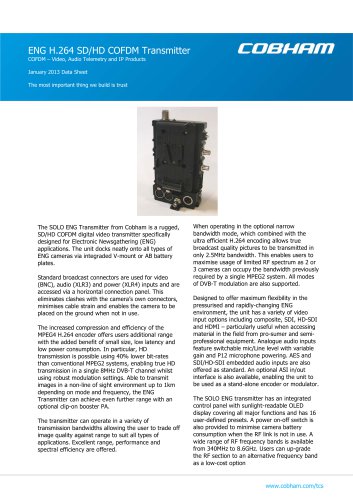
Catalog excerpts
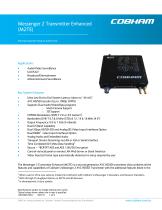
Messenger 2 Transmitter Enhanced (M2TE) The most important thing we build is trust. Audio/Video Surveillance UAV/UGV Broadcast/Entertainment Airborne/Ground Surveillance Ultra-Low End to End System Latency (down to ~44 mS)1 AVC HD/SD Encoder (Up to 1080p 30FPS) Supports Dual Audio/Video/Data programs o Multi-Camera Support o 3D Support COFDM Modulation (DVB-T 2 K or 4 K Carriers2) Bandwidths DVB-T 6,7,& 8 MHz (STD) & 12, 14 & 16 MHz (4 K2) Output Frequency: 0.9 to 7 GHz (In-Bands) Dual L/S Band Capability Dual 3Gbps HD/SD-SDI and Analog SD Video Input Interfaces Option Dual HDMI3 video Input Interfaces Option Analog Audio and Embedded Audio Transport Stream Streaming via LAN or ASI or Serial Interface Time Correlated KLV Meta Data handling3 Secure – *BCRYPT AES and AES 128/256 Encryption Control via local panel or remote LAN Web Server or Serial Interface Video Input(s) format type automatically detected-no setup required by user The Messenger 2 Transmitter Enhanced (M2TE) is a second generation AVC HD/SD transmitter that combines all the features and capabilities of Cobham’s Messenger 2 AVC HD/SD Transmitter with the additional features listed in the 1 Specifications subject to change without prior notice Typical values shown unless min or max is specified 100-DS0372X4 1OCT12 1 of 9 GMS Inc. doing business as Cobham Tactical Communications and Surveillance
Open the catalog to page 1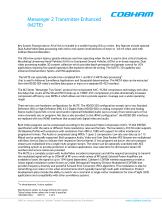
Messenger 2 Transmitter Enhanced (M2TE) Key System Features above. All of this is included in a smaller housing (8.6 cu inches. Key features include optional Dual Audio/Video/Data processing with end to end system-level latencies of down to ~44 mS when used with Cobham Receiver/Decoders. The Ultra-low system latency greatly enhances real-time operating when the link is used in time critical situations like piloting Unmanned Aerial Vehicles (UAVs) or Unmanned Ground Vehicles (UGVs) or in threat response. Dual video processing enables 3D content collection which provides depth perception and...
Open the catalog to page 2
Messenger 2 Transmitter Enhanced (M2TE) Our Messenger Receivers include an option for Spatial Maximal Ratio Pre-Detect Diversity Combining to combat multipath reflections found in indoor/urban environments. Cobham’s Messenger six or eight channel receivers with associated Messenger Antenna Arrays (MAAs) provide wide reception range without the hassle and cost of an auto tracking antenna system. The Messenger series Tx/Rx products provide a robust wireless link that is effective against the multipath interference experienced by analog systems and provides reliable data transmission in the...
Open the catalog to page 3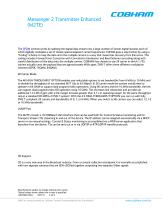
Messenger 2 Transmitter Enhanced (M2TE) The OFDM scheme works by splitting the digital data stream into a large number of slower digital streams each of which digitally modulate a set of closely spaced adjacent carrier frequencies. COFDM goes a step further by using a “Coding” scheme to map the data onto the multiple carriers in a way that maximizes recovery from link errors. This coding includes Forward Error Correction with Convolution Interleaves’ and Reed Solomon encoding along with careful distribution of the data onto the multiple carriers. COBHAM has chosen to use 2K carrier in which...
Open the catalog to page 4
Messenger 2 Transmitter Enhanced (M2TE) Content Collection Format The encoder maintains a frame by frame synchronization as it goes through its processing. AES Scrambling The AES Scrambling option can be used to add security to your data transmission. The system scrambles the payload portion of the TS packets. Only the TS header remains unscrambled to enable operation with standard DVBT receivers. The 128 bit-scrambling key is entered through the M2TE’s control interface. The user can enable or disable the scrambling as well as choosing if the key is stored within the Tx or not via Cobham’s...
Open the catalog to page 5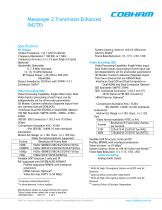
Messenger 2 Transmitter Enhanced (M2TE) Specifications RF Output Output Frequency: 1 to 7 GHz (In-Bands) Frequency Resolution5: 100 KHz or 1 MHz Frequency Accuracy: (+/-) 2.5 ppm (High-G Crystal Optional) Bandwidth: Selectable 6, 7, 8 MHz Standard 12, 14, 16 MHz Optional RF Output Power: < 20 mW to 200 mW, Adjustable Output Impedance: 50 Ohms with VSWR <1.5:1 Connector: SMA-F Video Encoding (HD) Video Processing Capability: Single Video input, Dual Video Inputs (processing of each input can be independently set for all encoder parameters) 3D Modes : Content collection (Separate inputs from...
Open the catalog to page 6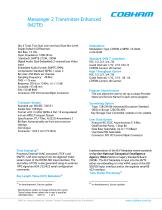
Messenger 2 Transmitter Enhanced (M2TE) Qty 4 Total, Two Dual, Line-Level and Dual Mic-Level, Single-Ended or Differential Mic Bias: 1.2 Vdc Input Impedance: 100K Ohms Standards: SMPTE-272M, -299M Digital Audio: Dual Embedded (2-channel) per Video input Embedded Audio Format: SMPTE 299M Compression Standard: MPEG-1 Layer 2 Bit rates: 256 Kbit/s per channel. Sampling Frequency: 48 KHz THD: < 1 % max. Response: 20 Hz to 15 KHz, (+/-) 1.5 dB Crosstalk: >55 dB min S/N: >50 dB RMS Connector: P/O I/O Control 68pin Connector Modulation Modulation Type: COFDM w/QPSK, 16-QAM, or 64-QAM Transport...
Open the catalog to page 7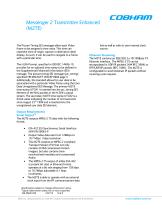
Messenger 2 Transmitter Enhanced (M2TE) The Picture Timing SEI messages allow each Video frame to be assigned a time value. This time can represent time of origin, capture or alternative ideal display. As such, it can be used to navigate to a frame with a particular time. The H.264 format, specified in ISO/IEC 14496-10 provides for an optional time stamp to be defined in the Supplemental Enhanced Information (SEI) message. The picture timing SEI message (pic_timing) specified HH:MM:SS:FF IAW RP 0604 page 5. Additionally, the standard allows for user data to be associated with a particular...
Open the catalog to page 8
Messenger 2 Transmitter Enhanced (M2TE) RTP (Real-time Transport Protocol) operates at the Application layer (OSI model) and it relies on UDP at the transport layer to transport real-time multimedia data across networks that use the Internet Protocol (IP). UDP is preferable to the Transmission Control Protocol (TCP) for real-time applications because it offers low-latency transport across IP networks. Control Local – Easy to use local control and status panel allows up to 20 user-defined operating modes covering most programmable parameters including Center Frequency, 4 Range Settings...
Open the catalog to page 9All Cobham catalogs and brochures
-
SAILOR® 900 VSAT KU
2 Pages
-
Model ST60
2 Pages
-
SAILOR 6140 mini-C Maritime
2 Pages
-
SAILOR 6110 mini-C GMDSS
2 Pages
-
SAILOR 6120 mini-C SSAS
2 Pages
-
SAILOR 6130 mini-C LRIT
2 Pages
-
sailor® 6150 mini-C Distress
2 Pages
-
SAILOR® 6391 Navtex SYSTEM
2 Pages
-
SAILOR® 100 GX
2 Pages
-
SAILOR® 600 VSAT KA
2 Pages
-
SAILOR 628X AIS
2 Pages
-
SAILOR SP3500 ATEX Portables
2 Pages
-
SAILOR SART II
2 Pages
-
SAILOR 6222 VHF DSC Class A
2 Pages
-
SAILOR 6215 VHF DSC Class D
2 Pages
-
Sea Tel 6004 Satellite TV
1 Pages
-
SAILOR 60 Satellite TV
2 Pages
-
Sea Tel ST88 Satellite TV
2 Pages
-
Sea Tel ST94 Satellite TV
2 Pages
-
Sea Tel ST144 Satellite TV
2 Pages
-
SAILOR® 150 FLEETBROADBAND
2 Pages
-
2 ATI GPS
2 Pages
-
Comant CI 317 Series
1 Pages
-
3D Synthetic Vision
4 Pages
-
SOLO4 ?Transmitter
2 Pages
-
VMD-T
3 Pages
-
Coaxial Cable Assemblies
76 Pages
-
Broadcast IP Encoder
2 Pages
-
RT-5000
2 Pages
-
sailor_sc4000_iridium
2 Pages
-
sailor 6000 series brochure
2 Pages
-
sailor 6300 mfhf brochure
4 Pages
-
sea tel 9797x
1 Pages
-
sea tel 4009x
1 Pages






































